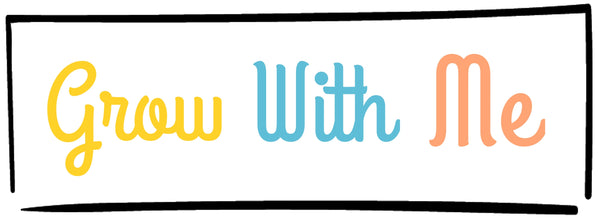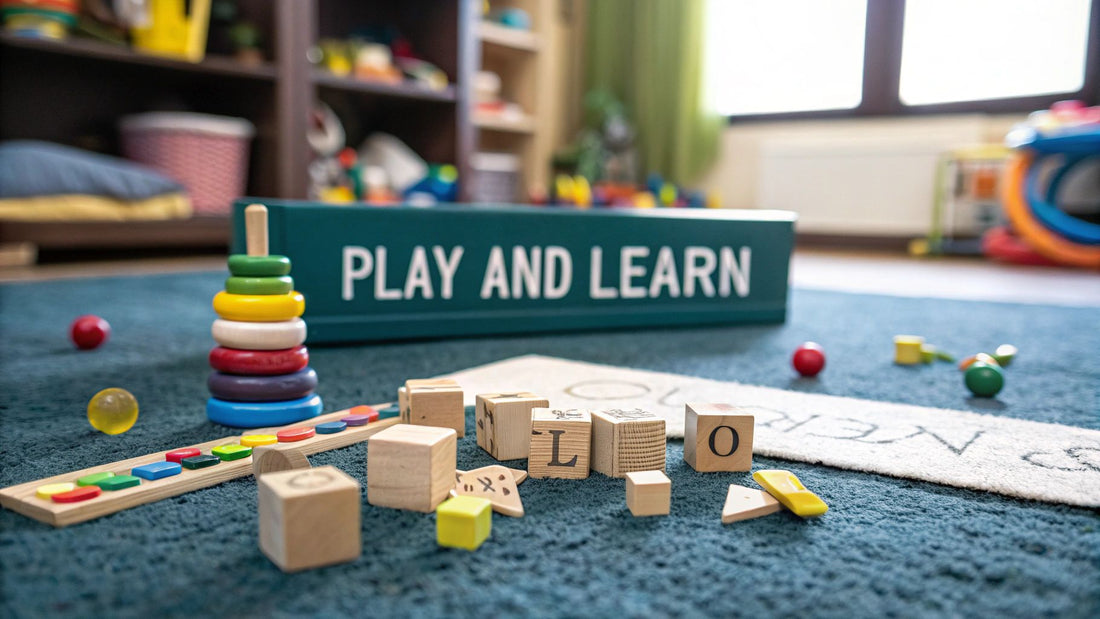
The Best Learning Toys for 1 Year Old Toddlers
Share
The absolute best learning toys for a 1 year old are the ones that are safe, champion key developmental milestones, and spark open-ended play. It’s the simple things, really. Toys like stacking rings, basic puzzles, and those classic push-along walkers are a perfect match for their budding motor skills and natural curiosity, turning a bit of fun on the floor into a powerful engine for growth.
The Wonderful World of Play and Learning at Age One
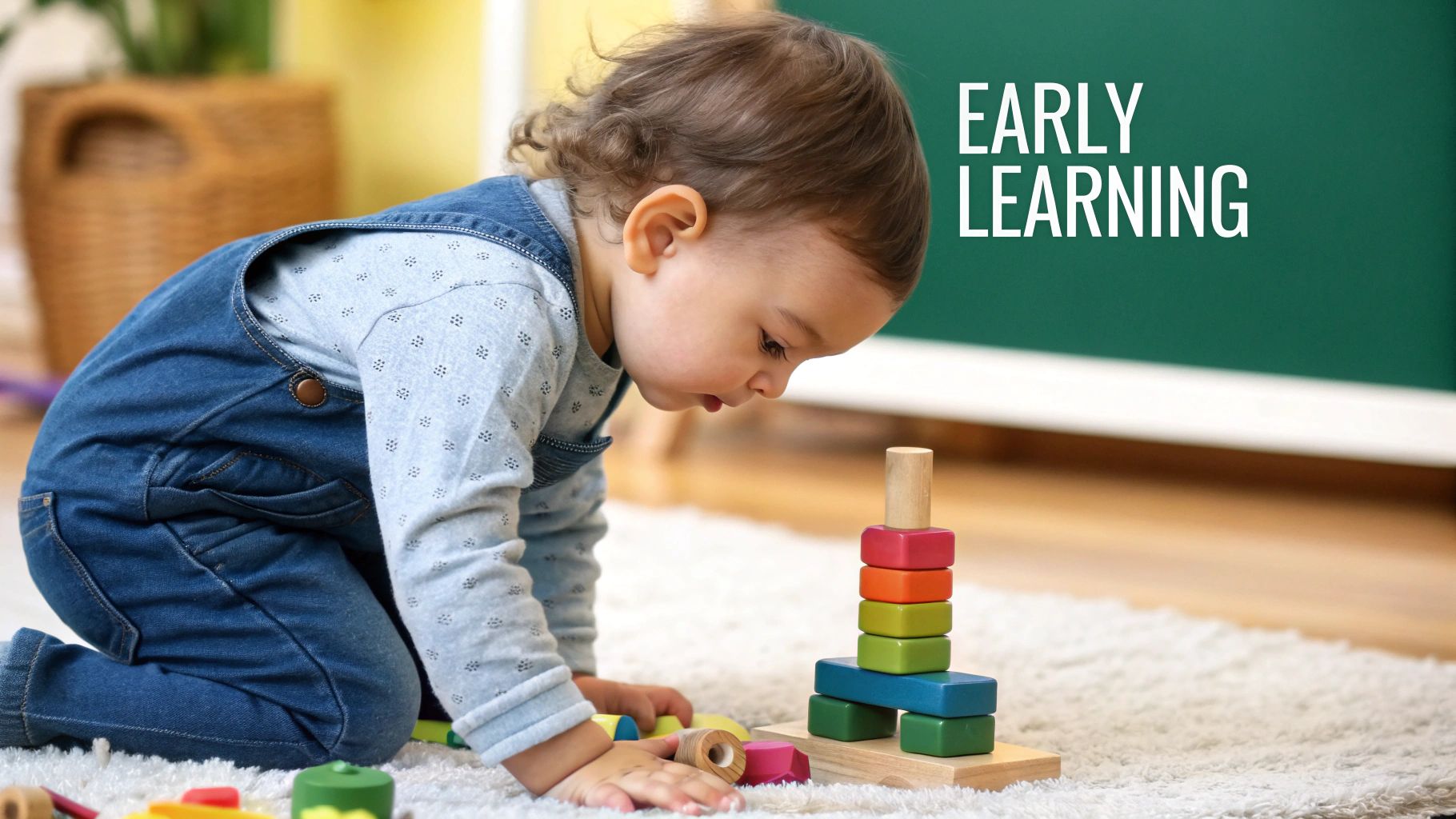
Welcome to one of the most magical years in your child's life. The time between 12 and 24 months is an absolute whirlwind of discovery. You’re watching your little one transform from a baby into a determined, exploring toddler right before your eyes. Every single object is a new puzzle to solve, and every interaction is a chance to learn something huge about the world.
During this stage, your one-year-old’s brain is like a sponge, just soaking up information from every sight, sound, and touch. They're just starting to connect the dots and realise their actions have consequences—a little concept we call cause and effect. It’s exactly why they get such a kick out of knocking over a tower of blocks or pressing a button to make a sound.
Nurturing Growth Through Purposeful Play
Purposeful play is really the heart of early learning. We’re not talking about structured lessons or flashcards here; it’s all about giving them the right tools to explore their own abilities and follow what interests them. The best learning toys for one-year-olds are designed to make this exploration feel completely natural.
Think of these toys as keys that unlock new skills. A simple shape sorter isn’t just a box with holes; it’s a hands-on lesson in problem-solving, spatial awareness, and fine motor control. In the same way, a set of stacking rings teaches concepts like size, order, and hand-eye coordination. These are the foundational skills that everything else will be built on.
Choosing the right toy means looking beyond the bright colours and flashy features. The most valuable toys are often the simplest ones, offering a blank canvas for your child’s imagination and developmental needs.
Aligning Toys with Key Milestones
To feel confident you're making good choices, it helps to understand how specific toys support key developmental milestones. At this age, your child is working on a massive range of new abilities, all at once.
- Fine Motor Skills: Developing that clever pincer grasp to pick up small objects.
- Gross Motor Skills: Taking those first wobbly steps or pulling themselves up to stand.
- Cognitive Growth: Grasping object permanence—knowing something still exists even when they can’t see it.
- Language Development: Babbling with intent and starting to understand simple instructions.
The right playthings act as catalysts for these skills. For parents who want a more guided approach, a well-designed toddler subscription box in the UK can provide stage-based toys that grow with your child. It's a great way to ensure they always have the perfect tools for their current developmental stage. This guide will walk you through how to pick toys that turn everyday play into truly meaningful learning opportunities.
What’s Happening in Your One-Year-Old’s World?
To pick the right tool for a job, you first need to know what you’re building. It’s exactly the same when choosing the best learning toys for a 1 year old. This isn't just about finding something to keep them busy; it’s about understanding the incredible developmental leap they're taking right now.
Think of your little one's brain as a buzzing construction site. New connections are firing every second, laying the groundwork for all future learning. Every texture they touch, every object they grab, and every sound they hear is another vital building block going into that amazing structure.
From Wobbly Steps to Precise Pinches
One of the most obvious changes you'll see is in their motor skills. We can split these into two main groups. First up are the gross motor skills, which use the big muscles in their arms, legs, and tummy. This is the raw power behind those first wobbly steps, the sheer determination in pulling themselves up on the sofa, and the giddy joy of cruising from one piece of furniture to the next.
Then you have the fine motor skills, which are all about those smaller, more delicate movements in their hands and fingers. This is where you see some real precision starting to emerge. You’ll spot them mastering the pincer grasp—that clever ability to pick up something tiny, like a dropped pea, between their thumb and forefinger. It might seem like a small thing, but it’s a massive step forward, paving the way for everything from feeding themselves to one day holding a crayon.
A simple set of stacking rings isn't just a toy. It’s a workout for the pincer grasp, a lesson in hand-eye coordination, and an early introduction to the concepts of size and sequence, all disguised as fun.
This visual shows exactly how different types of toys are designed to support these crucial areas of growth.
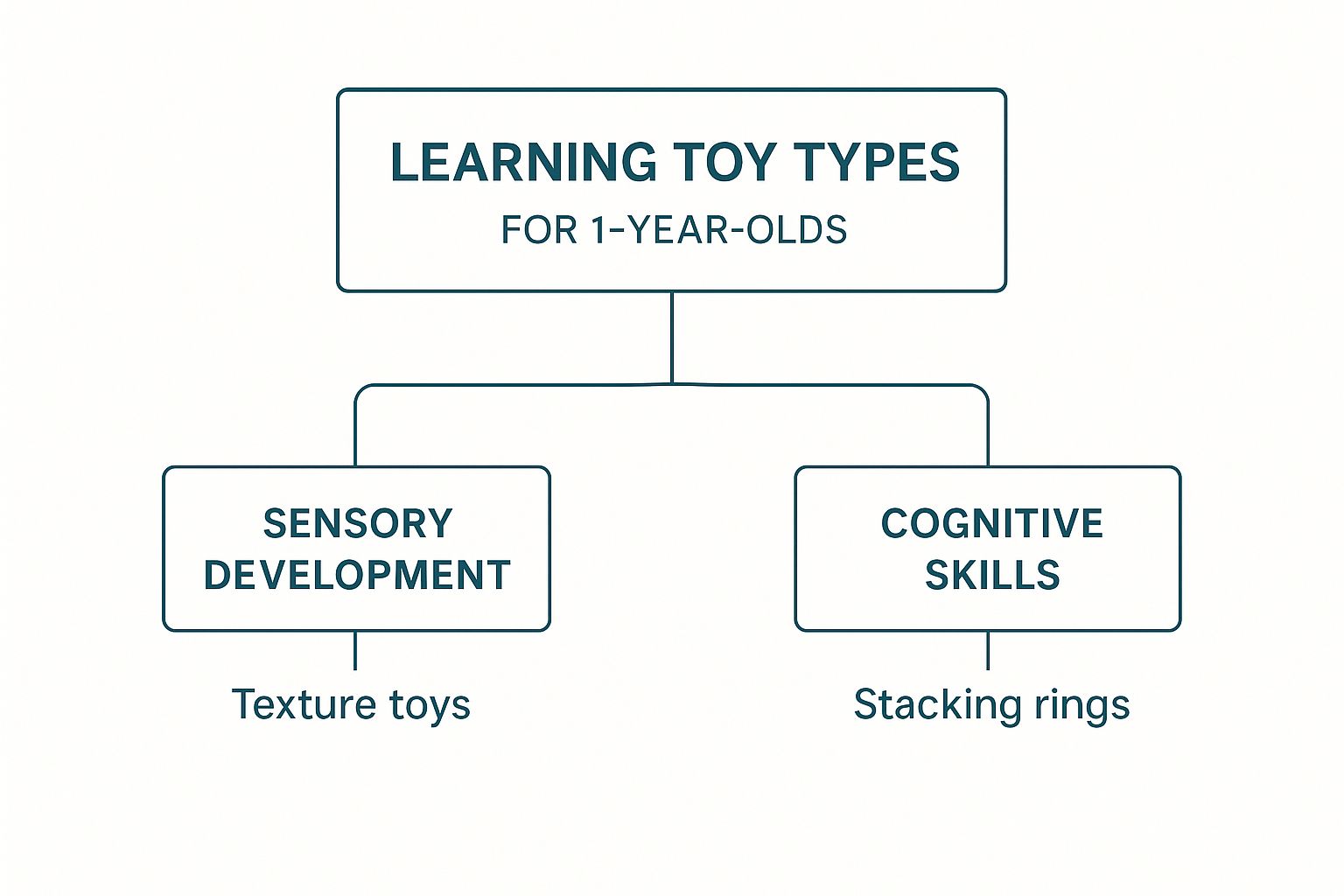
It’s clear from the image that toys like shape sorters or stacking rings aren't just random bits of plastic; they're purpose-built to help strengthen your child’s core abilities.
To make this even clearer, the table below shows how specific milestones connect directly with certain types of toys.
Developmental Milestones and Corresponding Toy Types for 1-Year-Olds
| Developmental Area | Key Milestones at Age One | Recommended Learning Toy Category |
|---|---|---|
| Gross Motor | Pulling to stand, cruising, may take first steps. | Push walkers, soft play climbers, ride-on toys. |
| Fine Motor | Developing the pincer grasp, stacking blocks, turning pages. | Stacking rings, large blocks, shape sorters, board books. |
| Cognitive | Understanding cause and effect, exploring object permanence. | Simple puzzles, pop-up toys, containers with lids. |
| Language | Babbling, saying first words, understanding simple commands. | Picture books, toy phones, simple musical instruments. |
| Social/Emotional | Imitating actions, showing preference for certain people. | Dolls, animal figures, puppets, mirrors. |
As you can see, the right toy at the right time is a powerful thing. It meets your child exactly where they are and gives them the confidence to take the next step.
Brainy Breakthroughs and Little Problem-Solvers
Beyond just moving their bodies, your one-year-old is having some huge lightbulb moments. They’re starting to properly understand cause and effect—the amazing idea that their actions can make things happen. Pushing a button to hear a song or dropping a block to hear it clatter isn't just mindless play; it’s a series of fascinating little experiments.
This is also when they really start to get their heads around object permanence. They're finally figuring out that when you hide their favourite teddy under a blanket, it hasn't vanished forever. It's why a game of peek-a-boo can keep them entertained for ages! Toys that play into this new skill, like simple puzzles or boxes for posting shapes, are fantastic for their growing minds.
First Words and Budding Friendships
Even if they only have a handful of words, their language skills are skyrocketing. They’re like little sponges, absorbing the sounds and rhythms of your voice and starting to link words to real things. By their first birthday, many toddlers can understand simple requests like "wave bye-bye" or "pass the ball."
This period is all about building those communication foundations.
- Durable Board Books: Pointing at pictures while you name the objects is a brilliant way to build their vocabulary and kick-start a lifelong love of reading.
- Simple Musical Instruments: A little drum or a set of shakers helps them explore rhythm and sound, which are closely tied to the patterns of language.
- Role-Play Items: A toy phone or a set of chunky farm animals can spark those first glimmers of imaginative play, encouraging lots of babbling "conversations."
When you understand these different but connected areas of development, you can choose learning toys for your 1 year old with real confidence. You're not just buying another toy; you're providing the perfect catalyst for their next big discovery.
What Makes a Great Learning Toy for a Toddler
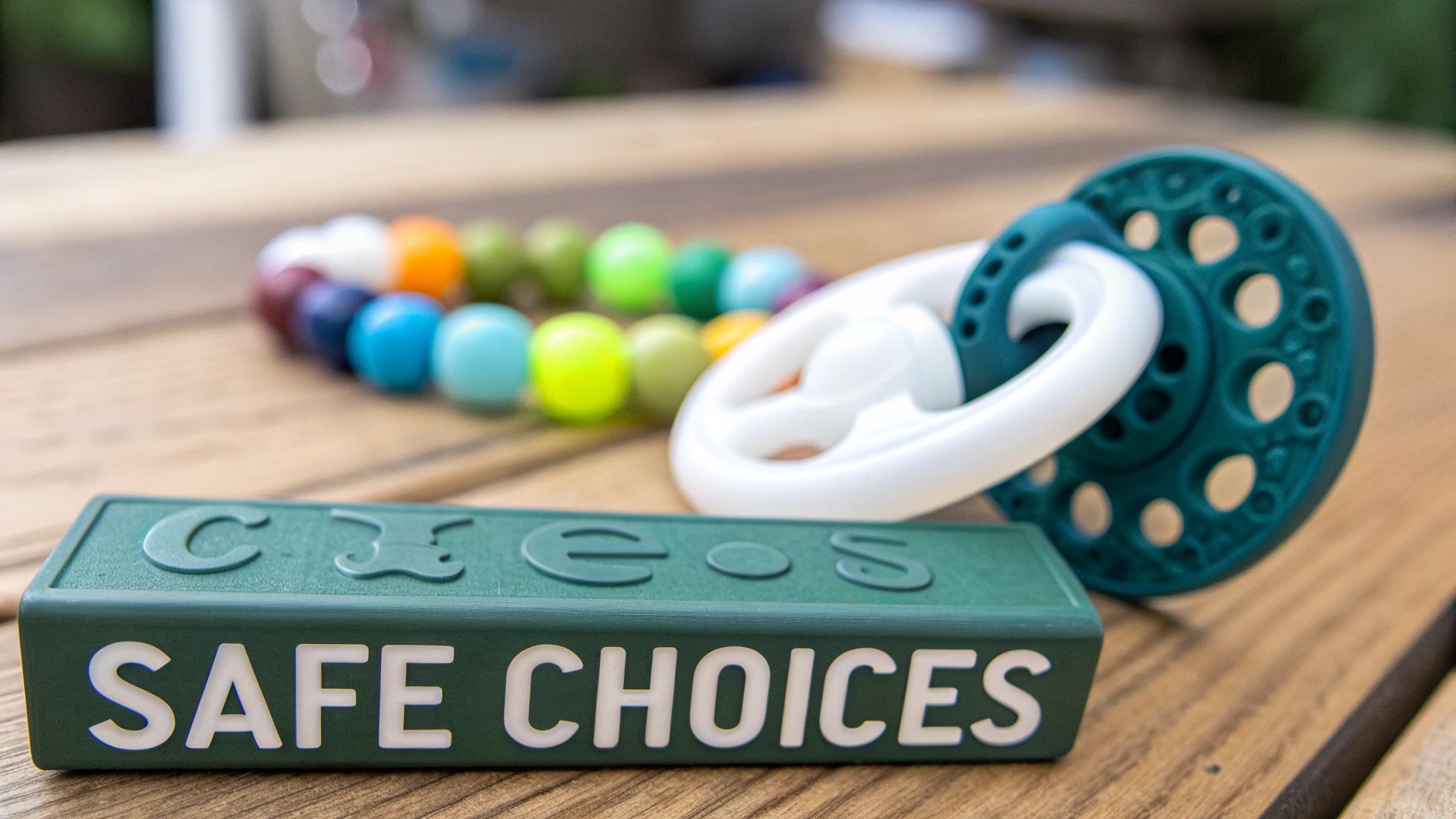
Let's be honest, walking down a toy aisle can be completely overwhelming. Everything is brightly coloured, plays a catchy tune, and claims to be the best thing for your child’s development. But what really separates a fantastic learning toy for a 1 year old from something that will be forgotten in a week?
The secret isn’t in the flashy lights or loud noises. It’s all about thoughtful design. The best toys act like a blank canvas for your toddler’s budding imagination, inviting them to explore rather than telling them exactly how to play. Once you know what to look for, you can see past the clever marketing and choose toys with genuine, lasting value.
Championing Open-Ended Play
The gold standard for a great learning toy is that it’s open-ended. This simply means it can be used in lots of different ways, limited only by your child's creativity. Picture a simple set of wooden blocks versus an electronic gadget that sings the same song every time a button is pressed.
That electronic toy has one job, and once your little one masters it, the learning fizzles out. The blocks, on the other hand? They can be a towering skyscraper, a fence for farm animals, a bridge, or a car. This kind of flexibility is a powerhouse for developing problem-solving skills and imaginative thinking every single time they play.
An open-ended toy doesn't tell a child what to do; it asks them, "What can you do with me?" This simple shift empowers them to become active creators in their own learning journey.
Stimulating the Senses
At one year old, the world is a giant sensory experiment. Toddlers learn about everything by touching, seeing, and hearing it. A toy that provides rich sensory stimulation is one of the most powerful tools for building those crucial neural connections in their rapidly growing brain.
Try to find toys that engage multiple senses at once:
- Touch: Look for a variety of textures – think smooth wood, soft fabric, or bumpy silicone.
- Sight: Toys with clear, contrasting colours are visually engaging without being overstimulating.
- Sound: Gentle, satisfying sounds that happen because of your child's actions are best. A soft rattle or a wooden xylophone is perfect.
This multi-sensory feedback helps them understand the world around them in a very direct, hands-on way. You can dive deeper into this idea in our guide to Montessori toys for toddlers.
Growing With Your Child
One of the most valuable, and often overlooked, features of a great toy is its longevity. The best ones adapt as your child grows, offering new challenges and ways to play at different developmental stages. This is the heart of what we call stage-based play.
Take a simple set of nesting cups. A 12-month-old might just enjoy banging them together and exploring their shape. A few months later, they’ll start figuring out how to stack them. By age two, those same cups become bowls in a pretend kitchen or tools for pouring in the bath.
This is a world away from single-purpose gadgets that are quickly outgrown and discarded. A toy that grows with your child offers far better long-term value and provides consistent, reliable developmental support.
This shift towards more purposeful toys isn't just a hunch; market trends show it too. The global educational toys market is expanding rapidly, with a projected value of £82.4 billion by 2029. It’s clear that parents are increasingly looking for toys that actively support their child's development.
A Checklist for a Great Learning Toy
When you're trying to decide if a toy is right for your one-year-old, just run through this quick mental checklist. It helps cut through the noise.
- Is it open-ended? Can it be used in many different ways to spark their imagination?
- Is it child-powered? Does the toy need my child's input to work, or does it just entertain them passively?
- Is it durable and safe? Is it made from high-quality, non-toxic materials built to withstand proper toddler chaos?
- Does it target a skill? Is it designed to help with fine motor, gross motor, or problem-solving skills?
- Will it grow with them? Can it be played with in new ways as their abilities advance?
By keeping these key features in mind, you stop just buying entertainment. You start building a thoughtful collection of tools that will support, challenge, and delight your child through their most formative year. It’s this exact philosophy that guides us in curating every Grow With Me play kit, ensuring each item is chosen for its profound developmental value.
Top Categories of Learning Toys for Your One Year Old
Knowing the theory behind great learning toys is one thing, but seeing it all click into place is where the real confidence comes from. So, let’s get practical and explore the specific kinds of learning toys for a 1 year old that really deliver the biggest developmental punch. These are the tried-and-tested classics that experts and parents come back to time and again, and for a simple reason: they just work.
Think of these categories as the essential food groups for your toddler's playtime diet. Each one nourishes a different, vital part of their growth. A well-rounded toy chest will have items from a few of these groups, making sure your little one gets support on all fronts, from taking their first wobbly steps to figuring out their very first puzzle.
Push and Pull Toys for Gross Motor Mastery
As your one-year-old starts to get steady on their feet, their world opens up in a huge way. They have this incredible drive to move, explore, and build up the strength in their legs, core, and arms. Push and pull toys are the perfect friends for this exciting stage, giving them the stability and encouragement they need to practise walking.
A classic wooden walker or a push-along animal isn't just offering physical support; it’s giving them a sense of purpose and control over how they move.
- Builds Core Strength: Pushing a toy forces them to engage their abdominal muscles, which is absolutely key for balance.
- Improves Coordination: They quickly learn to coordinate their hands, arms, and legs to move forward in a surprisingly controlled way.
- Sparks Confidence: Successfully making their way across a room with their favourite push toy is a massive confidence booster for an early walker.
When you're choosing one, look for something with a sturdy, wide base that won't tip over easily and wheels that have a bit of resistance. This stops the toy from running away from them!
Stacking and Sorting Toys for Problem Solving
While push toys get the big muscles working, stacking and sorting toys are like a gym for your toddler's brain and tiny fingers. These simple, often beautiful toys are absolute powerhouses for developing fine motor skills and introducing the first concepts of logic. A set of stacking rings or a basic shape sorter is a fundamental part of any learning toy toolkit.
Every time your child carefully places one ring on top of another, they’re practising their hand-eye coordination and pincer grasp. When they try to jam a square block into a round hole and realise it won’t go, they’re actually running a tiny scientific experiment.
These toys teach resilience. Trying, failing, and trying again to fit a shape into its correct slot is a child’s first hands-on lesson in problem-solving and perseverance.
They are learning about size, shape, and how things fit together in the most direct way possible. It’s this hands-on discovery that really makes the lesson stick.
Simple Puzzles and First Board Books
At this age, a puzzle isn’t about finishing the picture; it's all about the process of fiddling, turning, and discovering. Simple peg puzzles, with large, chunky pieces that have a small knob for easy gripping, are just right. They help your one-year-old develop spatial awareness and the fine motor control needed to rotate and place an object correctly.
In the same way, durable board books are one of the most important 'toys' you can own. Sharing a book together does so much more than just entertain; it builds a massive foundation for language.
- Vocabulary Growth: Pointing to pictures and naming the objects directly connects words to their real-world meanings.
- Introduces Concepts: Books can bring colours, animals, and daily routines to life in a fun, relatable format.
- Fosters Connection: Cuddling up to read a story is a powerful bonding experience that creates a positive association with reading for life.
Look for books with thick, sturdy pages they can turn themselves, paired with simple, clear illustrations.
Musical Instruments for Sensory Exploration
You don’t need to be raising the next musical prodigy to see the incredible benefits of early musical play. Simple instruments like a little drum, a xylophone, or a set of maracas are fantastic for sensory and cognitive development. They offer a perfect, immediate lesson in cause and effect: bang the drum, and it makes a loud noise!
This exploration of sound and rhythm is also closely tied to language development. It helps your child tune into the different patterns and cadences of speech. Plus, let's be honest, making music is a wonderful outlet for emotional expression and pure, uncomplicated joy. The goal isn’t a perfect melody; it’s the freedom to experiment and discover the power of their own actions.
How to Choose Safe and Age-Appropriate Toys
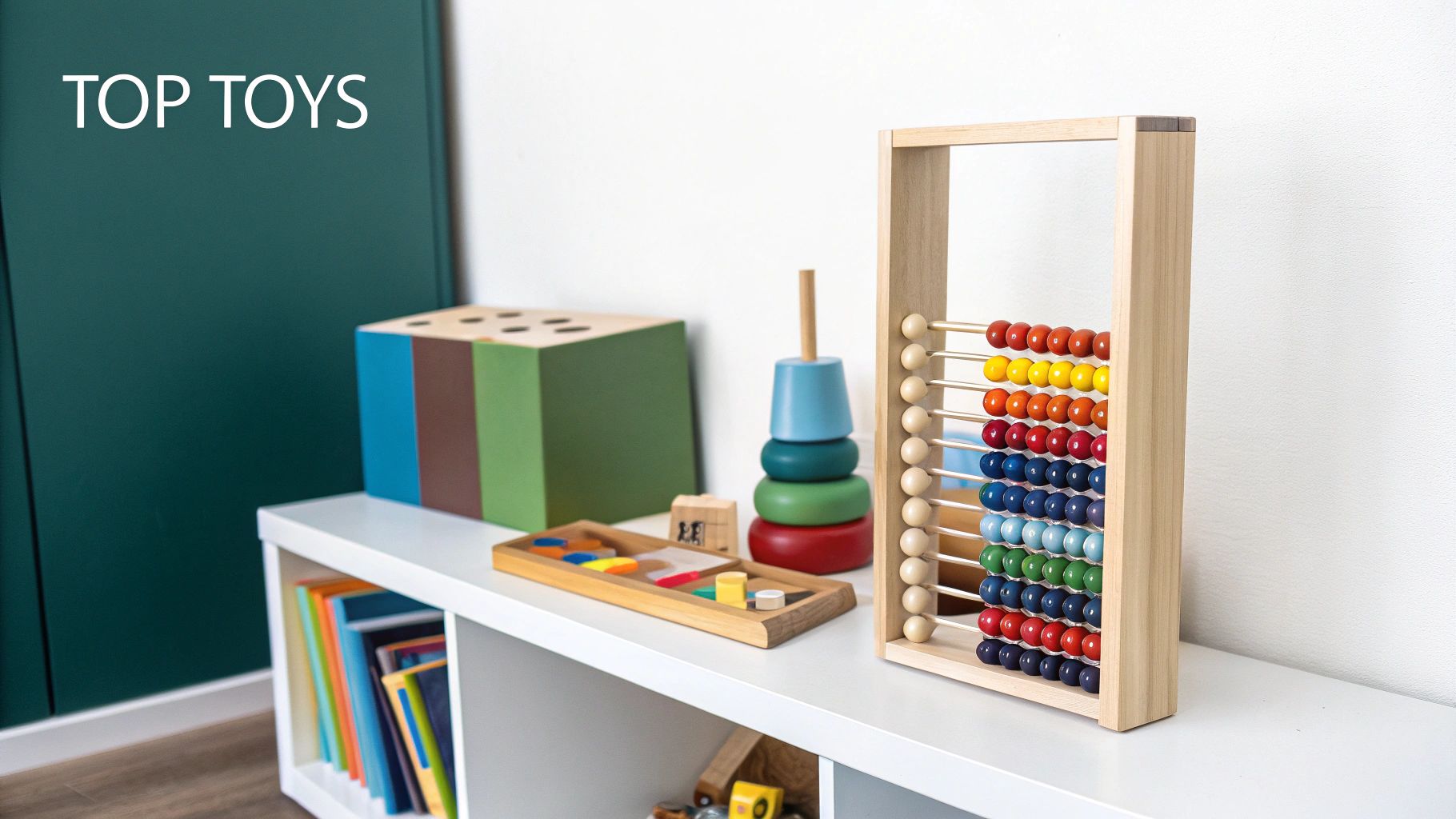
A toy might have all the learning potential in the world, but none of that matters if it isn't safe. And for a one-year-old, whose primary method of exploration involves their hands and mouth, safety is the number one, non-negotiable priority. It can feel a bit overwhelming trying to figure out what's safe and what isn't, but with a few pointers, you can learn to assess any toy with confidence.
Before you even consider bringing a toy home, the first thing to look for is an official safety certification. Here in the UK, that means keeping an eye out for the UKCA mark (UK Conformity Assessed) or the CE mark, which you might still find on some products. Think of these symbols as a toy's passport – they’re your guarantee that it’s been tested against strict standards for materials, design, and even flammability.
Identifying Common Physical Hazards
Beyond the official stamps of approval, your own hands and eyes are your most valuable tools for spotting potential dangers. One-year-olds are famous for putting everything they can find straight into their mouths, which makes choking a major risk.
There's a really simple trick for this: the toilet roll test. If a toy, or any piece that could potentially break off it, can fit completely inside a standard toilet roll tube, it’s too small for your little one. It's a surprisingly effective way to spot a choking hazard.
Besides small parts, you'll want to be on the lookout for a few other physical risks:
- Long Strings or Cords: Anything longer than 22 cm can pose a strangulation risk.
- Sharp Edges or Points: Have a good feel of the toy. It should be smooth all over, with no splintered bits of wood or sharp plastic edges.
- Gaps and Hinges: Check for any little gaps where tiny fingers could easily get trapped and pinched.
Choosing Non-Toxic and Durable Materials
What a toy is made of is just as crucial as its shape and size. At this age, you need materials that can stand up to some seriously enthusiastic (and often messy) play while being completely safe for the inevitable chewing.
When you're picking out a learning toy for a 1-year-old, try to stick with materials that are as natural and simple as possible. Your child is going to explore it with their mouth, so you need to be sure everything is made from safe, non-toxic components.
Your best bet is often the classics:
- Solid Wood: Go for sustainably sourced wood that’s been finished with non-toxic, water-based paints.
- BPA-Free Plastics: If you’re choosing plastic, make sure it's clearly labelled as free from BPA, phthalates, and PVC.
- Food-Grade Silicone: This material is a fantastic choice for teethers and sensory toys because it’s soft, flexible, and completely non-toxic.
It's clear that parents are increasingly seeking out high-quality, safe toys. The UK toy market is now valued at around USD 3.91 billion, and there's a strong shift towards products that support learning and development. This growth is being led by parents who really see the importance of safe, purposeful play.
Ultimately, choosing safe and appropriate developmental toys for toddlers comes down to being mindful and proactive. By checking for safety marks, inspecting for physical hazards, and choosing non-toxic materials, you’re creating a secure space where your child is free to learn, explore, and simply play. This care ensures every moment of fun is also one of safe discovery.
Got Questions About Toys for Your Toddler? We've Got Answers.
Stepping into the world of learning toys for a 1 year old can feel a bit overwhelming. With so many options out there, it’s natural to have questions. Let’s tackle some of the most common ones so you can feel confident you’re making the best choices for your little explorer.
How Many Toys Does My One-Year-Old Really Need?
It’s tempting to want to give them everything, but when it comes to toys, less is definitely more. Quality always trumps quantity.
A small, thoughtfully selected collection of 5-8 open-ended toys will do far more for your child’s development than a mountain of plastic that only does one thing. The trick is to offer a nice mix that covers different skills. Think about including a stacker for fine motor control, a pull-along toy to encourage walking, a simple puzzle for problem-solving, and a few sturdy board books to build early language. This curated approach helps them focus and play more deeply.
What About All the Flashing, Singing Electronic Toys?
They certainly know how to grab a child's attention, but the best learning toys at this age are the ones that are child-powered. Toys that need your little one to physically push, pull, stack, or imagine with them are the ones that build creativity and critical thinking.
A toy that performs for a child with the press of a button can turn them into a passive observer. Simple wooden blocks, on the other hand, invite them to be the director of their own play.
A Quick Tip on Toy Rotation:
Try putting some toys away for a few weeks and then swapping them back in. This simple trick keeps a smaller collection feeling fresh and exciting. It cuts down on clutter and encourages your child to rediscover and engage with each toy in new ways.
Are More Expensive Toys Automatically Better?
Absolutely not. Some of the best "toys" aren't even toys at all—think pots, pans, and cardboard boxes! The real value lies in how a toy sparks imagination and interaction.
The most effective toys are safe, durable, and encourage open-ended play, whatever their price. It's not about how much a toy costs, but about the rich, playful experiences it makes possible.
Ready to give your child the perfect, stage-based toys without all the guesswork? Discover how the curated play kits from Grow With Me deliver exactly what your child needs for their developmental stage, straight to your door.
Explore the Grow With Me play kits today and watch your little one thrive.
